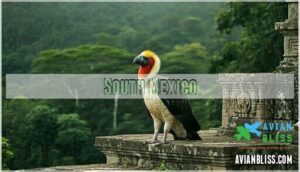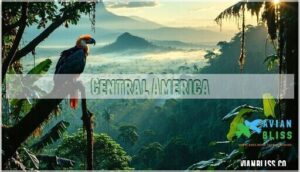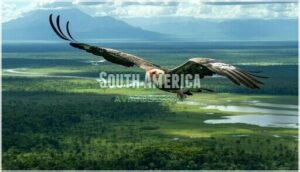This site is supported by our readers. We may earn a commission, at no cost to you, if you purchase through links.

They’re most comfortable in humid, warm climates below 1,500 feet elevation, though you might occasionally spot them venturing into foothills.
These impressive scavengers call the Neotropical region home, favoring dense rainforests, swamps, and marshy areas where they can spot carrion from above.
From the cloud forests of Costa Rica to Brazil’s Amazon basin, king vultures have claimed territory across 20 countries in Central and South America.
Their distribution tells a fascinating story about how these ancient birds adapted to diverse landscapes while maintaining strict habitat preferences.
Table Of Contents
- Key Takeaways
- Where Does The King Vulture Live?
- King Vulture Habitat
- Where Do King Vultures Live?
- King Vulture Distribution
- King Vulture Altitudinal Range
- Historical Distribution
- Food Availability and Habitat
- Disturbed Habitats and Feeding
- Conservation Implications
- King Vulture and The Ecosystem
- Frequently Asked Questions (FAQs)
- Where do the king vultures live?
- Where do you find king vultures?
- Do king vultures live in the Amazon rainforest?
- Are king vultures aggressive?
- Does the king vulture live in the Amazon rainforest?
- How many king vultures are left?
- How rare are king vultures?
- Where do king vultures live?
- Where do vultures live?
- Where do king vultures eat?
- Conclusion
Key Takeaways
- You’ll find king vultures across a massive range from southern Mexico to northern Argentina, covering about 14 million square kilometers through 20 countries in Central and South America.
- They’re strictly forest birds that prefer undisturbed tropical lowland forests, swamps, and marshy areas below 1,500 feet elevation, avoiding urban areas and open farmland.
- These scavengers play a crucial cleanup role in their ecosystems by consuming carrion and preventing disease outbreaks, making them essential indicators of healthy Neotropical forests.
- Habitat loss and deforestation are shrinking their range, particularly in northern areas like southern Mexico where populations have retreated up to 300 kilometers since the mid-1900s.
Where Does The King Vulture Live?
Anyone curious about the King Vulture’s address will find it’s got quite a spread. You’ll spot this striking bird across a vast range, stretching from southern Mexico all the way down through Central America and deep into South America, reaching northern Argentina and Uruguay.
Its habitat is closely tied to forests, making it a true forest-dependent species. Over time, though, range contraction and habitat fragmentation—mainly from human impact—have squeezed its living space.
Deforestation steadily shrinks these forest kings’ ancient kingdom, forcing them into smaller, fragmented patches of their once-vast domain.
While it prefers lower elevations, you might occasionally see it soaring up to 2,500 meters, testing its elevation limits. The King Vulture avoids urban areas, sticking to wild places.
Its presence is a reminder of how much healthy forests matter for wildlife survival in the Americas. These vultures play a pivotal role in ecosystem sanitation by consuming carrion.
King Vulture Habitat
You’ll find the king vulture in tropical forests, swamps, and marshy areas, where dense vegetation offers shelter and food sources.
This bird prefers undisturbed habitats, but it can show up near open woodlands and forest edges if there’s plenty of carrion around.
Tropical Forests
Step into the domain of king vultures and you’ll find them thriving in tropical forests, especially the dense rainforests of Central and South America.
Their presence highlights the importance of forest conservation and tropical biodiversity, especially as forest fragmentation threatens these essential habitats.
These birds rule the forest canopy, relying on the understory ecosystem for food and shelter, and their presence can signal healthy ecosystems.
- Nest in towering trees
- Patrol the Amazon rainforest
- Depend on intact habitat
- Signal healthy ecosystems
Swamps and Marshy Areas
Swamps and marshy areas are prime real estate for king vultures.
These humid wetlands, tucked inside tropical forests, offer abundant carrion thanks to thriving large mammals.
You’ll see their Marsh Adaptations at work—like cooling off with urohydrosis.
Wetland Conservation is vital, though, as Habitat Degradation threatens both Swamp Ecology and the king vulture habitat across South America.
| Feature | Detail |
|---|---|
| Swamp Ecology | Rich in carrion sources |
| Marsh Adaptations | Urohydrosis cooling |
| Avian Dependence | Essential feeding grounds |
| Habitat Degradation | Ongoing conservation need |
Where Do King Vultures Live?
You’ll find king vultures soaring across a vast range from southern Mexico through Central and South America, covering millions of square kilometers.
These birds stick to regions with dense forests and open woodlands, rarely straying near cities or busy farmlands.
King vultures avoid urban sprawl, preferring wilderness over civilization’s concrete jungles.
South Mexico
If you’re exploring vulture habitat in Mexico, you’ll spot King Vultures mainly in the south.
Oaxaca populations are shrinking, Chiapas sightings are rare, and Yucatan presence is patchy.
Migration patterns are limited, as these birds prefer staying put.
Habitat loss and human threats make their future uncertain in South Mexico, unlike their relatives across Central and South America.
- Oaxaca populations
- Chiapas sightings
- Yucatan presence
- Limited migration patterns
- Habitat loss
Central America
Central America’s wild heart is home to the King Vulture, soaring above dense jungles and remote wilderness.
You’ll spot them in places like Costa Rica’s Osa Peninsula, where population density is low and vulture habitat remains intact.
Conservation efforts here target habitat fragmentation, keeping these Central America vultures thriving within their broad vulture range.
| Region | Key Habitat | Conservation Focus |
|---|---|---|
| Osa Peninsula | Pristine Forests | Habitat Protection |
| Belize | Lowland Jungles | Anti-Fragmentation |
| Honduras | Remote Woodlands | Population Monitoring |
South America
Heading south, you’ll spot King Vultures soaring across South America’s wildest corners. Their vulture habitat stretches from Colombia’s forests to Argentina’s grasslands, adapting to every twist in the landscape.
Here’s where you’ll find them:
- Amazon Basin rainforests
- Andean Populations on rugged slopes
- Pantanal wetlands
- Coastal mangrove swamps
King Vultures play a pivotal role in ecosystem sanitation by consuming carrion. Regional Conservation is vital as Habitat Loss threatens their vulture range.
King Vulture Distribution
You’ll find the king vulture soaring across a vast range, from southern Mexico through Central and South America, all the way to northern Argentina and Uruguay.
Its distribution covers about 14 million square kilometers, so you won’t need a magnifying glass to spot its habitat on a map.
Argentina
In Argentina, the King Vulture’s southern distribution hugs the subtropical forests of Misiones, Formosa, Chaco, and Salta.
You’ll mostly spot them soaring above protected parks, steering clear of cities and farmlands.
Due to habitat loss, their conservation status is "Near Threatened."
These rare scavengers shape regional ecology and vulture interactions, quietly keeping Argentina’s forest floors clean.
Belize
If you’re birdwatching in Central America, Belizean Vultures are hard to miss.
King Vultures soar above the Maya Mountains, taking advantage of Belize’s vast forest cover and protected reserves.
Conservation efforts help offset habitat loss, while ecotourism impact supports local research.
You’ll spot them in:
- Towering ceiba trees for nesting
- Clear rivers as water sources
- Pristine beaches for feeding
- Ancient Mayan ruins as scenic perches
Their presence signals healthy vulture distribution and range, indicating a balanced ecosystem.
Bolivia
Leaving Belize’s lush forests behind, you’ll spot king vultures soaring above Bolivia’s Amazon Basin, Chiquitania, and even the Andean Highlands.
Their vulture population remains stable, thanks to protected areas, but forest fragmentation and shifting local perceptions pose real threats.
Conservation efforts focus on maintaining habitat and monitoring vulture distribution.
Here’s a quick look:
| Region | Habitat Type | Conservation Efforts |
|---|---|---|
| Amazon Basin | Lowland Forest | National Parks |
| Chiquitania | Savanna-Forest Mix | Biodiversity Monitoring |
| Andean Foothills | Gradual Zones | Transboundary Projects |
Brazil
You’ll spot king vultures gliding above Brazil’s Amazon Rainforest, patrolling the lush Pantanal Region, and hovering near coastal habitats.
These birds anchor local clean-up crews, feeding on remains most animals ignore, and are thus Masters of vulture interactions.
While habitat loss threatens their numbers, Brazil’s conservation efforts target safe spaces where vulture interactions support ecosystem health.
In South America, every king vulture matters, serving as Amazon Rainforest guardians, Pantanal Region clean-up specialists, and coastal habitat sentinels.
- Amazon Rainforest guardians
- Pantanal Region clean-up
- Coastal habitat sentinels
- Masters of vulture interactions
- Focused conservation efforts
Colombia
Colombia’s King Vulture glides between the Amazon rainforest and forest openings, perfectly adapted to both lowland and highland terrain.
Thanks to its altitudinal adaptations, you’ll see these scavengers from steamy jungle floors to cooler Andean slopes.
Their presence isn’t just dramatic—these birds shape the ecosystem, connecting Colombia’s Andean distribution to the broader fabric of South America’s habitats.
Conservation status remains a pressing concern.
Costa Rica
If you’re trekking through Costa Rica’s Osa Peninsula, keep your eyes skyward for King Vultures patrolling the treetops.
This Central American standout thrives in humid forests, though population status is challenged by habitat loss.
Conservation efforts and ecotourism impact how they fit into the local range, so their habitat plays a key role in survival.
Ecuador
Explore Ecuador and you’ll spot King Vultures soaring above the Amazon basin’s leafy giants.
These Amazonian vultures favor dense canopy, not coastal habitats, making Ecuador a hotspot for Andean King Vultures.
Their continued presence signals the health of this habitat.
Check out their lifestyle here:
- Majestic rainforest views
- Outstanding biodiversity
- Important Conservation Status
- Specific locations across eastern Ecuador
El Salvador
Leaving Ecuador behind, let’s look at El Salvador, where king vultures are feeling the squeeze.
Habitat fragmentation from deforestation impacts their range and population density.
Vulture conservation is tough here; these central America vultures struggle as human activity shrinks their king vulture habitat.
Conserving their habitats isn’t just admirable—it’s essential for El Salvador’s ecosystems and the broader network of Central America, making vulture conservation a critical task.
Guatemala
Head into Guatemala’s lush Maya Biosphere, and you’ll spot king vultures soaring overhead—guardians of the ecosystem and regulars in Central and South American forests.
Here’s why these birds matter:
- Reduce disease by consuming carrion
- Signal carcass locations for other scavengers
- Reveal Deforestation Impact on Vulture Population
- Fuel Ecotourism Potential with Conservation Efforts
Guyana
You’ll find King Vultures soaring above Guyana’s pristine tropical forests, where these magnificent scavengers play vital ecosystem roles.
Their range spans these undisturbed rainforests, supporting wildlife tourism while local perceptions recognize their ecosystem impact as nature’s cleanup crew.
Guyana’s Vultures benefit from the country’s extensive forest conservation efforts in South America, creating ideal habitat conditions.
Honduras
In Honduras, king vultures inhabit Central America’s tropical forests and wetlands, playing essential ecosystem roles.
However, habitat loss and hunting pressures threaten Honduran Conservation efforts, making local awareness vital for protecting vulture population stability in this biodiverse range.
Mexico
Mexico represents a critical northern boundary for King Vulture populations in Central America.
You’ll find these magnificent scavengers primarily in southern Mexico’s tropical lowlands, where habitat quality remains sufficient despite ongoing Range Contraction.
Historical Northern Expansion once extended their presence further north, but Habitat Loss has substantially reduced their Population Status.
Today’s Conservation Efforts focus on protecting remaining forest corridors essential for their survival.
Nicaragua
Nestled within Nicaragua’s tropical forests, the king vulture maintains a small but essential Nicaraguan population despite increasing vulture threats from habitat loss.
Conservation efforts in Central America focus on protecting these magnificent scavengers, while ecotourism impact creates both opportunities and challenges for their long-term survival across their range.
- Forest protection programs safeguard nesting sites
- Anti-deforestation initiatives preserve feeding territories
- Wildlife corridors connect fragmented habitats
- Community education reduces human-wildlife conflict
Panama
Throughout Panama’s lush tropical forests and the renowned Darién Gap, King Vultures maintain stable populations despite Canal Impact pressures.
These magnificent scavengers navigate Central America’s dense canopies, where habitat fragmentation threatens their range.
Conservation Efforts focus on preserving ecosystem health, as Population Density remains moderate.
Panama’s position linking South America guarantees these vultures access to diverse carrion sources across varied landscapes, supporting conservation efforts.
Paraguay
Paraguay’s vast Atlantic Forest and Pantanal wetlands provide ideal habitat for Paraguayan Vultures.
Despite habitat loss and future threats, conservation efforts by the South American Classification Committee help protect these regional ecology indicators.
In South America’s heart, King Vulture populations remain stable through:
- Accessing abundant cattle carrion in ranch lands
- Utilizing thermal updrafts over open grasslands
- Roosting in gallery forests along major rivers
Peru
Extensive rainforests across Peru provide ideal King Vulture habitat, particularly along eastern Andean slopes where these Amazonian vultures dominate the Peruvian ecosystem.
You’ll spot them soaring above pristine tropical forests, their keen eyesight scanning for carrion despite increasing habitat fragmentation threatening their conservation status throughout their range.
Characteristic Detail
Suriname
King Vultures call Suriname’s dense rainforests home, where they soar above the canopy searching for carrion.
These impressive scavengers dominate feeding sites throughout the country’s vast Forest Coverage and River Systems, though Human Impact increasingly threatens their habitat.
- Suriname Vultures inhabit pristine tropical forests covering 93% of the country
- River Systems provide ideal feeding corridors along forest edges and wetlands
- Human Impact from mining and logging fragments their traditional range
- Conservation Status remains stable due to Suriname’s extensive protected areas
Trinidad and Tobago
Rarity defines the King Vulture’s presence in Trinidad and Tobago.
You’ll find sporadic vulture sightings in Trinidad’s Northern Range forests, but these represent dispersing individuals rather than established populations.
Island populations face habitat loss and limited conservation efforts compared to mainland South America’s tropical forests.
| Feature | Details |
|---|---|
| Status | Vagrant species, non-resident |
| Habitat | Northern Range primary rainforest |
| First Record | 1953 near Arima Valley |
| Population | No breeding population established |
| Conservation | No targeted species introduction programs |
Uruguay
Contrary to earlier claims, king vultures don’t actually inhabit Uruguay.
Scientific records show no confirmed breeding populations exist there. Uruguay’s temperate grasslands lack the tropical forests these south america vultures require for nesting and roosting.
Here’s why vulture sightings remain absent from Uruguay:
- Habitat loss – Less than 10% forest cover versus Brazil’s 56%
- Regional threats – Agricultural conversion eliminates suitable neotropics habitat
- Future prospects – Conservation efforts focus on maintaining northern Argentina populations
The vulture species’ range stops short of Uruguay’s borders, where habitat incompatibility creates natural barriers for these forest-dependent scavengers.
Venezuela
You’ll find king vultures throughout Venezuela’s humid tropical forests, where habitat loss threatens their traditional range.
Conservation efforts focus on protecting the Venezuelan ecosystem, as these South America vultures depend on undisturbed tropical forests for nesting.
Their Andes distribution extends into mountainous regions where carrion remains abundant.
King Vulture Altitudinal Range
King vultures demonstrate remarkable altitudinal flexibility, inhabiting areas from sea level to elevations reaching 3,300 meters in the Andes Mountains.
You’ll find most populations concentrated below 1,500 meters, though these adaptable scavengers occasionally venture into montane forests near the treeline where carrion becomes available.
Lowland Forests
You’ll find King Vultures soaring through tropical forests and lowland forests, particularly in the Amazon rainforest where lowland biodiversity thrives.
These magnificent scavengers navigate the forest canopy and understory ecology with ease, adapting to various habitat conditions despite forest fragmentation.
Resource availability in these dense environments supports their scavenging lifestyle perfectly.
Mountainous Regions
High-altitude specialists navigate Andean slopes with remarkable altitudinal adaptations.
You’ll spot these scavengers soaring through montane forests up to 3,300 meters, approaching treeline habitats where few birds venture.
- Andes elevation records show king vultures reaching extraordinary heights near Colombia’s peaks
- Mountainous regions provide thermal updrafts essential for their energy-efficient gliding patterns
- Eastern Andean slopes offer prime hunting grounds with diverse wildlife populations
- Altitudinal range flexibility allows exploitation of both lowland rainforests and high-altitude zones
Historical Distribution
While king vultures soar across diverse elevations, their historical distribution tells a fascinating story of range changes over centuries.
You’ll find these magnificent birds once occupied a broader Past Range extending further into Northern Mexico and possibly the Southeastern US during the 18th century.
Their historical distribution across the Americas originally covered approximately 14.3 million square kilometers throughout the Western Hemisphere.
However, Range Contraction has substantially altered their presence.
Habitat Changes from deforestation and agricultural expansion have pushed populations southward, with northern limits retreating up to 300 kilometers in southern Mexico since the mid-1900s.
| Time Period | Geographic Extent | Population Impact |
|---|---|---|
| Pre-1500s | Mexico to Argentina | Stable, widespread |
| 1500s-1800s | Documented by explorers | Thriving populations |
| 1900s-Present | Contracted northern range | Declining in periphery |
| Current Status | Core habitat in tropics |
Fragmented distribution.
This range shift reflects humanity’s expanding footprint on their pristine forest habitat.
Food Availability and Habitat
Food availability shapes where you’ll spot king vultures across their range.
Carrion abundance in tropical forests and rainforests determines their habitat selection, with these accomplished scavengers seeking areas rich in large mammal carcasses.
Forest fragmentation creates edge habitats where livestock and wildlife mortality increase food availability.
While habitat disturbance from agriculture disrupts nesting sites, it paradoxically enhances foraging opportunities near cattle operations.
King vultures dominate feeding hierarchies at carcass sites, using their powerful beaks to access food other vultures can’t.
Their scavenging ecology involves waiting for smaller species to locate carrion, then asserting dominance.
This efficient ecosystem cleanup role connects habitat quality directly to prey availability, ensuring these magnificent scavengers thrive where death naturally occurs in forest ecosystems.
Understanding habitat suitability factors is essential for their conservation.
Disturbed Habitats and Feeding
While food availability determines where you’ll find king vultures thriving, their foraging behavior reveals remarkable adaptability.
Though these scavengers prefer pristine forests, habitat fragmentation forces them into disturbed habitats when necessary. You’ll spot them near cattle ranches and agricultural land, where carcass proximity increases substantially.
Their scavenging ecology involves waiting for smaller vultures to open tough hides before asserting dominance with their powerful beaks.
Human impact creates both challenges and opportunities:
- Deforestation destroys nesting sites, forcing birds into vulnerable situations
- Cattle operations provide reliable carrion sources, creating feeding hotspots
- Agricultural expansion fragments their traditional territories, isolating populations
- Road kills offer unexpected food sources but increase collision risks
Despite preferring undisturbed environments, king vultures demonstrate impressive flexibility when hunger calls, adapting their ancient feeding strategies to modern landscapes.
Conservation Implications
Protecting these magnificent scavengers requires urgent action as Habitat Loss threatens their survival across the Americas. Population Decline continues as tropical forests disappear to agricultural expansion, while Poaching Threats and Climate Change compound existing pressures.
You’ll find Conservation Efforts focusing on three critical areas:
- Establishing protected corridors connecting fragmented habitat patches to maintain genetic diversity
- Implementing anti-poisoning campaigns targeting secondary toxicity from pesticide-laced carcasses
- Developing cross-border monitoring programs across their 20+ nation range
Strategic conservation planning must balance development with ecosystem preservation to guarantee King Vulture populations recover. International cooperation is key, as migratory bird conservation requires coordinated policies.
King Vulture and The Ecosystem
Throughout the Americas, you’ll find the King Vulture serving as nature’s cleanup crew in tropical forests and surrounding ecosystems.
These remarkable scavengers play three critical roles that maintain ecological balance and health.
Ecosystem Role
Impact
—
Carrion Consumption
Disease Control
Nutrient Recycling
The King Vulture’s position in the scavenger hierarchy demonstrates nature’s efficient design.
While they can’t tear through tough hides like condors, they dominate feeding sites once carcasses are opened.
This ecosystem cleanup prevents disease outbreaks that could devastate wildlife populations.
Their strong stomach acid neutralizes harmful bacteria, making them perfect biological recyclers.
When you observe these birds in their habitat, you’re witnessing millions of years of evolutionary perfection—living garbage disposals that keep tropical forests healthy and thriving.
Frequently Asked Questions (FAQs)
Where do the king vultures live?
King vultures inhabit tropical forests from southern Mexico to northern Argentina, covering 3 million square kilometers. You’ll find them in lowland rainforests, swamps, and woodland edges, typically below 1,500 meters elevation.
Where do you find king vultures?
Spanning 3 million square kilometers, you’ll discover king vultures from southern Mexico through Central America to northern Argentina.
They inhabit tropical lowland forests, swamps, and woodland edges, preferring pristine areas below 1,500 meters elevation.
Do king vultures live in the Amazon rainforest?
Yes, you’ll find king vultures throughout Brazil’s Amazon rainforest, where they inhabit the uppermost forest canopy and forage at river edges, forest openings, and clearings adjacent to dense tropical vegetation.
Are king vultures aggressive?
Surprisingly, you’ll find king vultures aren’t aggressive fighters despite their intimidating appearance.
They don’t engage in violent competition for food, instead relying on dominance through size and presence to claim feeding spots, which showcases their unique approach to securing resources, highlighting their use of presence.
Does the king vulture live in the Amazon rainforest?
Absolutely, you’ll find king vultures throughout the Amazon rainforest, where they soar above the canopy hunting for carrion. They’re perfectly adapted to this lush environment, nesting in tree hollows.
How many king vultures are left?
Between 10,000 and 100,000 king vultures remain in the wild, but you’re witnessing a silent decline. Despite its "least concern" status, habitat destruction continues chipping away at populations across their tropical range.
How rare are king vultures?
King vultures aren’t extremely rare, but you’ll find their populations declining across their range from southern Mexico to Argentina.
They’re classified as least concern globally, though habitat loss threatens local populations substantially.
Where do king vultures live?
You’ll find king vultures throughout tropical forests from southern Mexico to northern Argentina, spanning roughly 14 million square kilometers. They prefer undisturbed lowland rainforests below 1,500 meters elevation.
Where do vultures live?
Vultures inhabit six continents except Antarctica and Australia, with over 20 species thriving worldwide.
You’ll discover these scavengers across Africa’s savannas, Europe’s mountains, Asia’s forests, and the Americas’ tropical regions, adapting to diverse climates from deserts to rainforests, which is a key factor in their ability to thrive in various environments, such as rainforests.
Where do king vultures eat?
You’ll find these scavengers feeding at forest openings, river edges, and disturbed areas near tropical forests.
They dominate feeding sites, often eating carcass eyes first while waiting for other vultures to open tough hides, which is a key behavior in their dominate role.
Conclusion
From pole to pole, king vultures have painted their presence across the Americas’ most vibrant ecosystems.
Understanding where does the king vulture live reveals their remarkable adaptability within specific environmental constraints.
You’ll find these majestic scavengers thriving from Mexico’s southern reaches to Argentina’s northern territories, consistently choosing lowland tropical forests below 1,500 feet elevation.
Their distribution across 20 countries demonstrates how habitat preferences shape wildlife ranges, making them essential indicators of healthy Neotropical ecosystems throughout Central and South America, highlighting their role in indicating environmental constraints.















